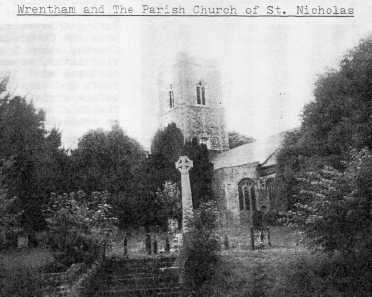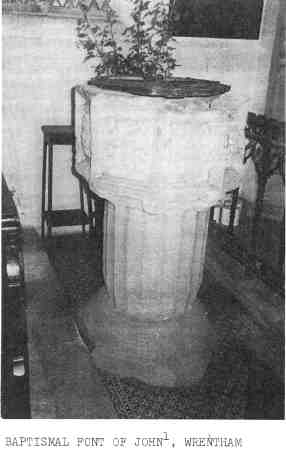

A couple of years ago, my wife, Gladys, and I made a trip to England for the purpose of visiting some of the sites associated with our ancestral heritage. We saw Baguley Hall, Bowden Church, wherein rests the effigy of Sir Wm. de Baguley, Ollerton Hall and some places in Lincolnshire. One of the most interesting facets of the trip was a visit to Wrentham - the hometown of John Biglo, Biggalough, Beagley, whatever. Numerous articles have appeared in past issues of FORGE regarding Baguley- and Ollerton Halls and I would have little to add. I have not seen any information regarding Wrentham, so I should like to share some of my observations on that very interesting locale.
One can reach Wrentham by taking a train to Norwich and from there to Lowestoff on the North Sea. It is only a 5 or 6 mile ride from the station to Wrentham were there is a very nice 18th century Inn called the "Spread Eagle." This Inn has a
 WRENTHAM
AND JOHN Cont.
WRENTHAM
AND JOHN Cont.
distinctly Dutch exterior - the Netherlands lying just across the sea from this coast. A few blocks south from the inn, is Chapel Lane. Here one takes a right turn and walks about a half-mile to St. Nicholas', the parish church of Wrentham. During this walk, you will pass the Congregational Church, which I shall mention later, several old cottages with thatched roofs and some open country before arriving at the church crossroads. A taxi is available, if needed.
The parish church is somewhat isolated, west of town, with only one nearby building - as I remember. This old building has a beautifully sculptured thatched roof and, thanks to the efforts of the present rector, has been identified as the old guild hall and is therefore now protected by the antiquity laws of Britain. The parish cemetery does not have any ancient graves. I saw no "Beagley" tombstones and the rector told me that he knew of no "Beagleys" or "Baguleys" in Wrentham. The reason that this church is not in Wrentham "proper"
at this time, is because in the 18th century, a new turnpike was constructed to the east, closer to the coast, changing the flow of traffic. As the decades passed, the town gradually migrated eastward, leaving the church to stand almost alone.
The rector of the church was the Rev. Mr. Spratt, a very charming, gracious and erudite gentleman. He took an hour of his valuable time to show us around and to fill us in on the history of the place. Later he kindly invited us to the rectory for some tea and then gave us a lift back to the inn.
I was fascinated by the church, It had stood for several centuries before John 1 was baptized there in 1616/17. We saw the very font in which he was baptized, perhaps fortuitously, since during the Puritan depredations it had been thrown out, only to be discovered many decades later, serving as a half-buried flower container in the garden, from whence it was returned to the sanctuary.
 On
the floor of the main aisle, is a magnificent memorial brass of Ela Bowet,
a patroness of St. Nicholas' in the late 14th century. On it is a dedicatory
latin poem. Rev. Spratt informed us that it was one of the oldest of such
memorials to a woman in all of England. If I remember correctly, she was
the sister of the Earl of Suffolk and therefore had considerable clout
in this parish. I am certain that John walked over the brass many times
in his youth.
On
the floor of the main aisle, is a magnificent memorial brass of Ela Bowet,
a patroness of St. Nicholas' in the late 14th century. On it is a dedicatory
latin poem. Rev. Spratt informed us that it was one of the oldest of such
memorials to a woman in all of England. If I remember correctly, she was
the sister of the Earl of Suffolk and therefore had considerable clout
in this parish. I am certain that John walked over the brass many times
in his youth.
As one looks down the interior of the church, it is quite obvious that the walls are wider apart at the ceiling than at the floor - although they are plumb on the outside. The reason is that St. Nicholas is the patron saint of sailors and the sanctuary was intended to imitate the shape of a ship's hull, on the inside.
In the church records appears the name of John Pillip, 23rd rector of St. Nicholas, the same man who baptized John and so testified in New England that John Biglo was the same person. ((see list of rectors in this edition of FORGE, Ed.)). In 1638, Phillip left for New England due to conflict with the Established Church resulting from his Cromwellian sympathies and Puritan persuasion, He returned to England and was again rector in 1641. In 1649, he left the Church and formed a Congregational church which is still in use in Wrentham. After the Restoration, St. Nicholas' again took to the Book of Common Prayer - in 1662.
Unfortunately we were on a tight schedule and could not spend more time in Suffolk. We had originally intended to spend some time in the Nayland area, near Ipswich, where Mary Warren's family came from. Incidentally, Wrentham was once the property of Wm. de Varren (Warren).

